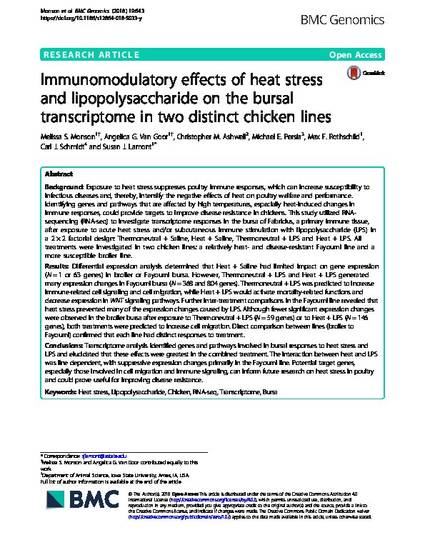
Background: Exposure to heat stress suppresses poultry immune responses, which can increase susceptibility to infectious diseases and, thereby, intensify the negative effects of heat on poultry welfare and performance. Identifying genes and pathways that are affected by high temperatures, especially heat-induced changes in immune responses, could provide targets to improve disease resistance in chickens. This study utilized RNAsequencing (RNA-seq) to investigate transcriptome responses in the bursa of Fabricius, a primary immune tissue, after exposure to acute heat stress and/or subcutaneous immune stimulation with lipopolysaccharide (LPS) in a 2 × 2 factorial design: Thermoneutral + Saline, Heat + Saline, Thermoneutral + LPS and Heat + LPS. All treatments were investigated in two chicken lines: a relatively heat- and disease-resistant Fayoumi line and a more susceptible broiler line.
Results: Differential expression analysis determined that Heat + Saline had limited impact on gene expression (N = 1 or 63 genes) in broiler or Fayoumi bursa. However, Thermoneutral + LPS and Heat + LPS generated many expression changes in Fayoumi bursa (N = 368 and 804 genes). Thermoneutral + LPS was predicted to increase immune-related cell signaling and cell migration, while Heat + LPS would activate mortality-related functions and decrease expression in WNT signaling pathways. Further inter-treatment comparisons in the Fayoumi line revealed that heat stress prevented many of the expression changes caused by LPS. Although fewer significant expression changes were observed in the broiler bursa after exposure to Thermoneutral + LPS (N = 59 genes) or to Heat + LPS (N = 146 genes), both treatments were predicted to increase cell migration. Direct comparison between lines (broiler to Fayoumi) confirmed that each line had distinct responses to treatment.
Conclusions: Transcriptome analysis identified genes and pathways involved in bursal responses to heat stress and LPS and elucidated that these effects were greatest in the combined treatment. The interaction between heat and LPS was line dependent, with suppressive expression changes primarily in the Fayoumi line. Potential target genes, especially those involved in cell migration and immune signaling, can inform future research on heat stress in poultry and could prove useful for improving disease resistance.
Available at: http://works.bepress.com/max-rothschild/256/

This article is published as Monson, Melissa S., Angelica G. Van Goor, Christopher M. Ashwell, Michael E. Persia, Max F. Rothschild, Carl J. Schmidt, and Susan J. Lamont. "Immunomodulatory effects of heat stress and lipopolysaccharide on the bursal transcriptome in two distinct chicken lines." BMC genomics 19 (2018): 643. doi: 10.1186/s12864-018-5033-y.